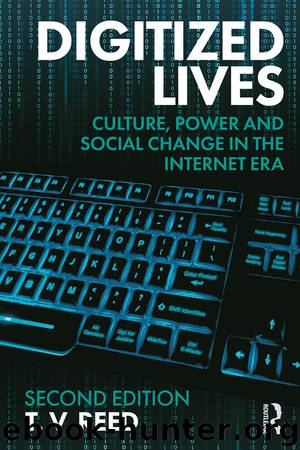Digitized Lives by T.V. Reed

Author:T.V. Reed
Language: eng
Format: epub
Publisher: Taylor and Francis
Published: 2018-12-06T16:00:00+00:00
Digitized Sex Trafficking
All sides of the online sex debates agree that one absolutely indefensible form of violence as implicated in pornography is the trafficking and forcing of women, girls and boys to engage in sex acts online (and offline). Without doubt this is the ugliest, most exploitative dimension of technology: Its deployment to assist in sexual trafficking and other forms of violence against women, girls and boys. Trafficking of women, girls and boys long precedes the rise of new communications technologies. But many suggest the new media have played a role in expanding trafficking in recent decades, and there can be little doubt that ICTs have changed the nature of trafficking. Trafficking has long been a transnational phenomenon, usually from poorer countries to richer ones, and increasing global economic inequality due to the forces of globalization has intensified trafficking. The current phase of globalization itself is of course deeply dependent on new media technologies (Kee 2005).
Mobile phones, GPS devices and email have facilitated communication among traffickers and allowed them to better track their victims. Legal “email order brides” websites promise pliant, marriage-ready women and girls; on the surface they represent “soft” forms of trafficking, but they often serve as a front for hardcore trafficking. Underground illegal websites have digitized the promotion of trafficked women, girls and boys. Once again, the anonymity that comes with using the Net plays a crucial role, allowing traffickers and their customers to conduct business online with little risk of being identified. Peer-to-peer trafficking networks, where individuals arrange the transfer of trafficked women, girls or boys, has arisen alongside older organized trafficking networks. The vast increase in the amount of pornography represented by the mainstreaming of porn has significantly increased the demand for sex workers, and a considerable portion of the new recruits to the porn industry are trafficked individuals. Some argue that the “trafficking in images” is a less dangerous, less overtly violent, form of trafficking, but far too often the publication of images is accompanied by or enabled by other physically exploitative activities. While the exact portion of non-consensual pornographic filming is impossible to measure, it is very difficult to view pornography online and be sure one is not supporting trafficking. There is no way to tell whether a woman you are viewing online has consented to her performance. Some groups are working to develop what some call “ethical porn” or “fair trade” porn, which eliminates racism and sexism and guarantees that all depicted sex acts are consensual. This includes a feminist porn movement that produces films that provide female actors equal pay with males, assures that all the filmed events are consensual and overall portrays sex in non-exploitative ways.
Neither the general expansion of trafficking nor its various digital manifestations has gone unchallenged. And many of the same digital communication technologies that have been used by traffickers have been used against traffickers and trafficking. Anti-trafficking organizations can use ICTs to track traffickers and help locate trafficked people. Online information for victims and potential victims
Download
This site does not store any files on its server. We only index and link to content provided by other sites. Please contact the content providers to delete copyright contents if any and email us, we'll remove relevant links or contents immediately.
| Anthropology | Archaeology |
| Philosophy | Politics & Government |
| Social Sciences | Sociology |
| Women's Studies |
Cecilia; Or, Memoirs of an Heiress — Volume 1 by Fanny Burney(32437)
Cecilia; Or, Memoirs of an Heiress — Volume 2 by Fanny Burney(31873)
Cecilia; Or, Memoirs of an Heiress — Volume 3 by Fanny Burney(31857)
The Great Music City by Andrea Baker(31508)
We're Going to Need More Wine by Gabrielle Union(18972)
All the Missing Girls by Megan Miranda(15588)
Pimp by Iceberg Slim(14398)
Bombshells: Glamour Girls of a Lifetime by Sullivan Steve(13977)
Talking to Strangers by Malcolm Gladwell(13231)
Norse Mythology by Gaiman Neil(13211)
Fifty Shades Freed by E L James(13161)
For the Love of Europe by Rick Steves(13066)
Mindhunter: Inside the FBI's Elite Serial Crime Unit by John E. Douglas & Mark Olshaker(9206)
Crazy Rich Asians by Kevin Kwan(9170)
The Lost Art of Listening by Michael P. Nichols(7411)
Enlightenment Now: The Case for Reason, Science, Humanism, and Progress by Steven Pinker(7239)
The Four Agreements by Don Miguel Ruiz(6636)
Bad Blood by John Carreyrou(6558)
Weapons of Math Destruction by Cathy O'Neil(6148)
